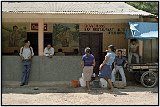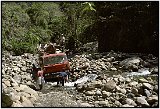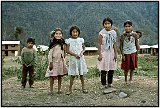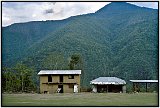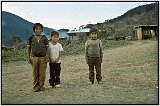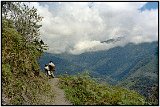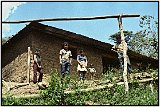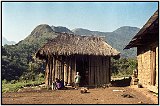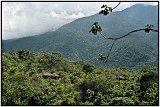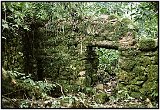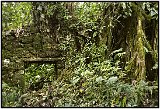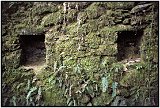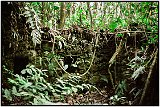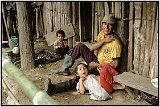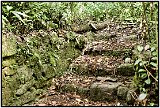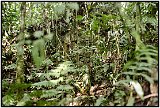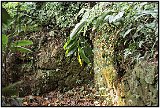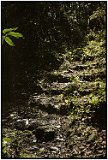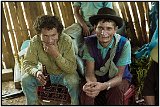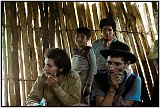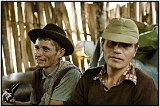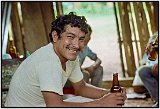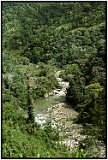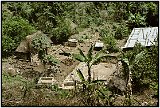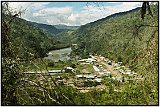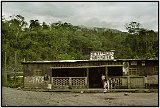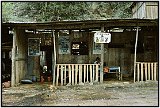"Visual Quotations"
Photographs by Richard Freeman
Espíritu Pampa
When the Inca Empire fell to the Spaniards a band of Inca led by Manco Inca Yupanqui established a small state out of the Spaniards way, and managed to keep their independence until they finally fell to the Spanish around 1558. The ruins were forgotten for many years. Recently (around the 1960s) these ruins were discovered and eventually it was agreed upon that they were the lost city of Espíritu Pampa, also known as Vilcabamba.
For myself and Robyn, my traveling companion at that time, it was a true adventure. The existence of the ruins were known, but unlike the other great Inca ruins, there was no excavation, and no amenities for tourists. We felt like true explorers. First, we were not supposed to be in that area because of some recent activity by Sendero Luminoso (The Shining Path). Not that we had a death wish, but as we traveled we checked with the locals about the presence of any Sendero and were reasonably assured that they had left to the next valley, and it was safe for the moment. This took place in August 1986.
The adventure started with the train from Cuzco that stops at Machu Pichu. We stayed on the train to the last stop, the jungly town of Quillabamba on the Urubamba River (a second trip we took from Quillabamba was a day’s journey down this incredible river, several images are in the “Nature’s Way” portfolio). From there we took a ride on a truck, which followed the semi-dry river bed further into the interior. This passage is not possible during the rainy season. We spent the night in Kiteni (see the images of the “hotel” and café). The next day we took another truck ride. This was followed by two days hiking. We spent one night in a small village. The residents let us sleep on the floor of their one-room school. The two local teachers, who were from Cuzco, were excited to have visitors and invited Robyn and I to their place for dinner. Luckily my Spanish was pretty good by then. The residents of this town had been chased out by Sendero terrorists for 6-months and only recently returned. Sendero had taken all their livestock, but the residents were happy no one was killed and that they were eventually able to return.
On our final approach to the ruins, I noticed we were walking on what looked like a covered up, deliberately built, set of stairs. We began to see more signs of Inca occupation. Finally we found a small coffee farmer’s compound, which we were told to look for. The head of the family was Osvaldo, and his family was his wife and two young daughters. Osvaldo was very gracious, and let us pitch our tent in his compound. We brought him a gift of a flashlight and several sets of batteries, and some sweets for his children. He told us that he also had to flee his compound because of Sendero and that they took all his livestock. They also tried to get him to join them. He also was lucky they did not kill him for refusing. Osvaldo then asked, if they were supposedly “for the people” how could they expect him to leave his family and his small coffee crop? Who would harvest? Who would feed his family? He wanted nothing to do with them.
The next day was Sunday, and Osvaldo did not have to go to the fields and offered to take us to see the ruins. This was very lucky for us. The ruins are not very obvious. We followed Osvaldo along a trail until he suddenly turned off and started hacking his way through the bush. Not too far off that path (but far enough that Robyn and I seriously were almost lost when we returned by ourselves the next day) we suddenly found ourselves in what appeared to be a room, whose floor was built up by centuries of jungle growth. We saw a wall and an entranceway. The floor was too high to use the entranceway and there was a fully mature tree that had grown on top of the wall. It was exhilarating to be standing there!
After our dramatic visit the next day, Robyn and I had to travel back for 4-days, the same way we came. In one town we ended up celebrating our successful adventure over some beers with a few of the town’s residents. One of the men was buying the beer for the others. One of these men said to me, “See, he is our local representative, but we only see him when there is an election and he comes around and plies us with free beer so we vote for him.” There are photos of the men below.
We did eventually make it back to Quillabamba, took our overnight trip on the Urubamba, and eventually made it back to Cuzco, which felt like a huge modern metropolis! I had been there for nearly 3-months, staying with a family who rented out beds. It was good to be home.
©2017 Richard Freeman. All rights reserved.
